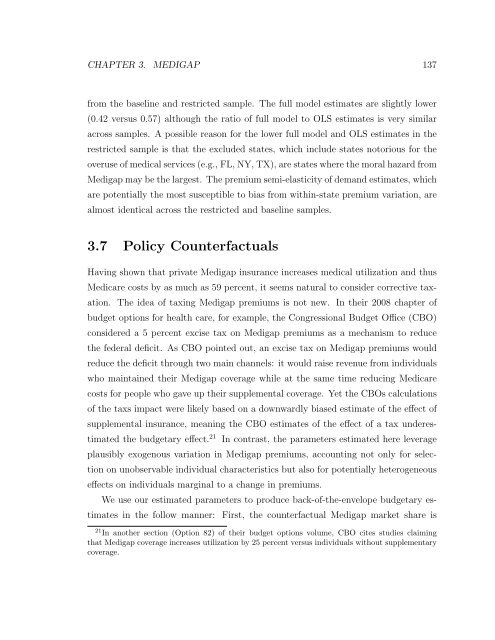essays in public finance and industrial organization a dissertation ...
essays in public finance and industrial organization a dissertation ...
essays in public finance and industrial organization a dissertation ...
Create successful ePaper yourself
Turn your PDF publications into a flip-book with our unique Google optimized e-Paper software.
CHAPTER 3. MEDIGAP 137<br />
from the basel<strong>in</strong>e <strong>and</strong> restricted sample. The full model estimates are slightly lower<br />
(0.42 versus 0.57) although the ratio of full model to OLS estimates is very similar<br />
across samples. A possible reason for the lower full model <strong>and</strong> OLS estimates <strong>in</strong> the<br />
restricted sample is that the excluded states, which <strong>in</strong>clude states notorious for the<br />
overuse of medical services (e.g., FL, NY, TX), are states where the moral hazard from<br />
Medigap may be the largest. The premium semi-elasticity of dem<strong>and</strong> estimates, which<br />
are potentially the most susceptible to bias from with<strong>in</strong>-state premium variation, are<br />
almost identical across the restricted <strong>and</strong> basel<strong>in</strong>e samples.<br />
3.7 Policy Counterfactuals<br />
Hav<strong>in</strong>g shown that private Medigap <strong>in</strong>surance <strong>in</strong>creases medical utilization <strong>and</strong> thus<br />
Medicare costs by as much as 59 percent, it seems natural to consider corrective tax-<br />
ation. The idea of tax<strong>in</strong>g Medigap premiums is not new. In their 2008 chapter of<br />
budget options for health care, for example, the Congressional Budget Office (CBO)<br />
considered a 5 percent excise tax on Medigap premiums as a mechanism to reduce<br />
the federal deficit. As CBO po<strong>in</strong>ted out, an excise tax on Medigap premiums would<br />
reduce the deficit through two ma<strong>in</strong> channels: it would raise revenue from <strong>in</strong>dividuals<br />
who ma<strong>in</strong>ta<strong>in</strong>ed their Medigap coverage while at the same time reduc<strong>in</strong>g Medicare<br />
costs for people who gave up their supplemental coverage. Yet the CBOs calculations<br />
of the taxs impact were likely based on a downwardly biased estimate of the effect of<br />
supplemental <strong>in</strong>surance, mean<strong>in</strong>g the CBO estimates of the effect of a tax underes-<br />
timated the budgetary effect. 21 In contrast, the parameters estimated here leverage<br />
plausibly exogenous variation <strong>in</strong> Medigap premiums, account<strong>in</strong>g not only for selec-<br />
tion on unobservable <strong>in</strong>dividual characteristics but also for potentially heterogeneous<br />
effects on <strong>in</strong>dividuals marg<strong>in</strong>al to a change <strong>in</strong> premiums.<br />
We use our estimated parameters to produce back-of-the-envelope budgetary es-<br />
timates <strong>in</strong> the follow manner: First, the counterfactual Medigap market share is<br />
21 In another section (Option 82) of their budget options volume, CBO cites studies claim<strong>in</strong>g<br />
that Medigap coverage <strong>in</strong>creases utilization by 25 percent versus <strong>in</strong>dividuals without supplementary<br />
coverage.










